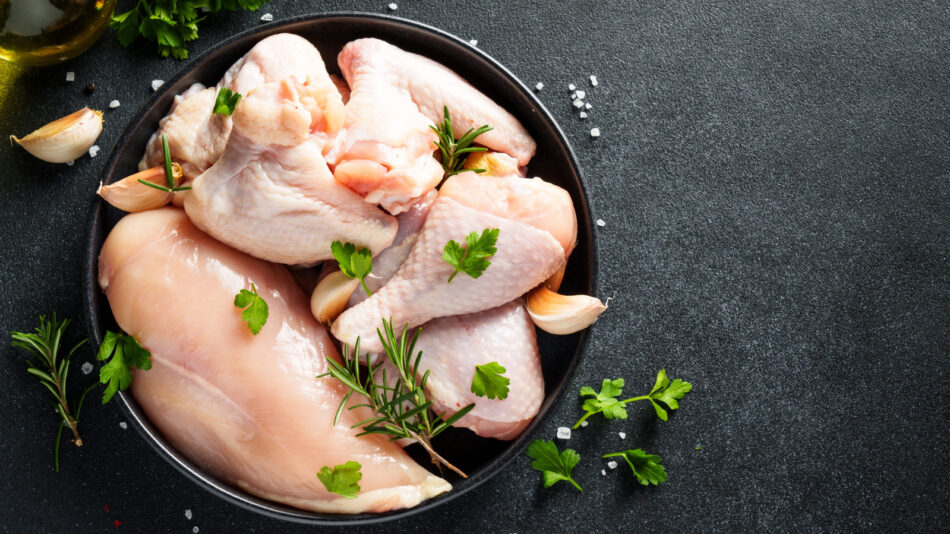When it comes to meats, chicken is a popular choice due to factors such as availability, affordability, and versatility, propelling it to the top of the meat eating totem poll, falling short of just pork. Chicken’s multicultural popularity can be seen in how it’s used across various cuisines — whether it’s battered and fried, tossed in spicy sauces, used in a Thai red curry recipe, or turned into a crispy and saucy chicken parmesan recipe. Chicken’s nutritional content has a huge part to play in its popularity as well. While red meats such beef may offer more protein compared to chicken, they are also higher in saturated fats. Chicken, on the other hand, is a great source of lean protein that’s packed with essential amino acids and micronutrients such as zinc, iron, and potassium.
Needless to say, chicken is a staple food source across many countries. According to Poultry World, the planet as a whole consumed 120 million tonnes of chicken in 2021 — a figure that’s projected to reach a whopping 180 million tonnes by 2050. So the question is: Which countries contribute the most to these figures and eat the greatest amount of chicken?
Based on a study conducted by World Population Review, China and the U.S. consumed a total amount of 24,436 and 18,111 kilotons of chicken respectively in 2022. Chicken is similarly popular in other countries such as Mexico and Brazil, though its consumption is considerably lower due to smaller populations. Let’s take a closer look at the top five countries that consume the most chicken.
China (24,436 KT)
Be it kung pao or crispy fried Sichuan, China’s culinary landscape revolves around chicken. In 2022, China topped the chicken consumption charts by eating a total of 24,436 kilo tonnes of chicken, surpassing countries like the U.S. Chicken is more than just a source of sustenance in China — it also has great symbolic value. Its cultural significance may play a huge role in its consumption in China, along with the country’s extremely high population.
For example, according to Chinese tradition, a chicken that’s served whole (with its head and feet) signifies strength and unity. Whole chickens are also symbols of wealth and fortune and are offered to ancestors during ceremonies in order to seek their blessings. Many who live in China are firm believers in consuming all parts of the chicken to make the most of the whole bird. From its feet to its head and even the claws, it can all be devoured.
America (18,111 KT)
The U.S. comes second in global consumption, and chicken is the most consumed meat in the country. Think of spicy chicken nuggets or barbecue chicken wings — the American fast food environment thrives on chicken to the point where many franchises, such as KFC and Chick-fil-A, feature chicken as the central offering. This created a fast food revolution where chains catered to a broader audience by providing health conscious options along with the conventional fast food staples. Dishes like grilled chicken salads and chicken breasts with vegetables now go hand in hand with fried chicken and sandwiches.
The growing price of beef and other meats also played into chicken’s ascension to the top of the meat chain in America’s fast food diaspora. With the current trajectory of economic affairs and the cost of living going through the roof, most Americans wholeheartedly welcome chicken as their source of protein.
Brazil (10,131 KT)
Brazil is the biggest exporter of chicken in the world (according to Avi News), supplying the lean protein to major consumer markets like China and Saudi Arabia. Apart from exporting, Brazil has a strong culinary bond with the bird and consumes a lot of the chicken that it produces. Dishes such as tempero baiano (chicken marinated in a zesty spice blend) or galinhada mineira, (chicken, rice, and vegetables cooked together in a single pot) are everyday staples in the Brazilian cuisine and fine examples of chicken-based dishes that are rooted in the country’s culture.
Brazil’s consumption of chicken also ties in with a boom in its fast food industry, with big and small restaurants popping up throughout the country. This is also aided by the growing work culture that leaves employees with less time to cook. With chicken at its center, these food establishments range from bigger global chains like KFC to smaller, street side eateries selling traditional Brazilian dishes such as coxinha (a deep-fried chicken croquette) and caldo de mandioquinha (a velvety parsnip and chicken soup).
Russia (4,953 KT)
Due to Russia’s incredible landmass, different regions within the country have different culinary identities based on their topography and cultural heredity and utilize the meat options available to them. However, due to its affordability and accessibility, Russians eat and export a lot of chicken. In 2024, the country reached new heights in terms of consumption of meat, with chicken and pork emerging as the key candidates contributing to this growth. 2024 also saw a 25% increase in Russian chicken exports to countries such as China and Saudi Arabia, with the total amount of exports reaching 420,000 tonnes, increasing by 2.1% from 2023, according to Poultry World.
In addition to Russia’s exporting prowess, the country’s cuisine also features various dishes that revolve around chicken and are packed with flavor. Take chicken borscht for example, a warm and comforting soup that’s the ideal companion to the harsh weather conditions of some Russian regions. There’s the simple and hearty chicken stroganoff as well. Olivier salad is another example of Russia’s culinary diversity and is made of vegetables and chicken or beef with a mayonnaise dressing.
Mexico (4,950 KT)
When you think of Mexico, the first few things that come to mind might be juicy, meaty tacos and crisp, smooth tequila. But if you dive deeper into Mexico’s culture and cuisine, you’ll realize just how popular chicken is in the country and how the majority of its culinary ecosystem is built around it. Chicken not only features in usual staples like tacos and fajitas, but there are also many dishes that highlight the lean protein. There’s tinga, made from shredded chicken that’s slowly simmered in a spicy base of onions, chilies, tomatoes, and garlic, and chicken chili verde, a stew of chicken thighs cooked in a base of chili sauce.
Considering how central chicken is to Mexican cuisine, Mexico’s high ranking among the meat consuming nations of the world should come as no surprise. While its consumption of 4,950 kilo tonnes of chicken may seem small compared to bigger nations like China, we need to take into consideration the disparity between the population of the two countries. With that context in mind, Mexico’s chicken consumption number may be small, but its love and appetite for the bird sure isn’t.








